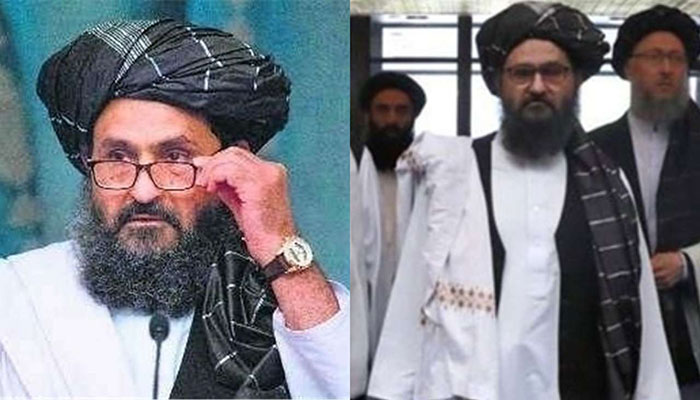Who is Mullah Ghani Baradar
LAHORE: The 53-year-old key Afghan leader, Mullah Abdul Ghani Akhund or Mullah Baradar, was nicknamed “Baradar,” which means brother, by Mullah Omar, the spiritual leader of the Taliban and the de facto 11th head of state of the war-torn nation from 1996 to late 2001.
Baradar, a Durrani Pashtun by ethnicity, was deemed to be a key confidant of Mullah Omar, whom he had befriended when both were in their teens and fighting the Soviet Red Army together. According to the BBC News and New York Times archives, Mullah Baradar was arrested in Karachi by the Pakistani and American intelligence agencies in February 2010, and then released on October 24, 2018, amid Washington's push for peace talks.
The formidable Taliban leader was subsequently appointed to be the chief of the Taliban's diplomatic office in Doha, Qatar. He was taken into custody in a morning raid on Madrassa Khuddamul Quran - near the Nooriabad Industrial Estate, some 45km from Karachi.
The American government had played an active role in his release. Research shows that in September 2013, the-then Nawaz Sharif regime in Pakistan had seemingly extended an olive branch to the otherwise “resilient” and "resolute" Ghani Baradar, and many media houses had predicted his early release from prison.
The New York Times had revealed the Pak agencies was also assisted by the American CIA in the operation against Mullah Baradar, who had been subjected to United Nations sanctions including a travel ban, an arms embargo and the freezing of assets. The American newspaper had maintained that the prisoner was the most significant Taliban figure to be detained since the US-led war in Afghanistan began in 2001.
The BBC News had asserted: “Correspondents say Mullah Baradar is reported to be in charge of all long-term strategic military planning for the Taliban in southern Afghanistan and, if confirmed, his arrest will have a very big effect on the Taliban's ability to conduct the insurgency there. Senior US officials said Mullah Baradar was "providing intelligence."
However, the-then Taliban spokesman Zabihullah Mujahid had denied the reports while talking to the Reuters news agency, saying Mullah Baradar was still in Afghanistan actively organising the group's military and political activities.
The “BBC” had added: “Little is known about Mullah Baradar, but in terms of influence he is said to rank second only to the Taliban's spiritual leader, Mullah Muhammad Omar, who has been hiding from Western agencies since the 9/11 terror attacks in 2001. Mullah Baradar was quoted last year as telling his troops not to confront US soldiers with their superior firepower, but to adopt guerrilla tactics. He is said to be responsible for the Taliban tactic of planting "flowers" - Improvised Explosive Devices (IEDs) - along roadsides.”
According to the July 24, 2009, edition of the esteemed Newsweek magazine, Mullah Abdul Ghani Baradar would hop on a motorcycle and drive his old friend (Mullah Omar) to safety in the mountain in November 2001 as the Taliban defenses were crumbling during their war against the US-backed Northern Alliance.
The magazine had written: “In more than two dozen interviews for this profile, past and present members of the Afghan insurgency portrayed Baradar as no mere stand-in for the reclusive Omar. They say Baradar appoints and fires the Taliban's commanders and governors;
presides over its top military council and central ruling Shura in Quetta, where most of the group's senior leaders are based; and issues the group's most important policy statements in his own name.”
Ghani Baradar, the co-founder of the Taliban movement in Afghanistan, had served as Afghanistan’s Deputy Minister of Defence during the pre-2001 Taliban regime. He had headed a couple of provinces as Governor too.
-
 Carson Beck Girlfriend Rumours Explained Amid CFP Championship Run
Carson Beck Girlfriend Rumours Explained Amid CFP Championship Run -
 Sean Penn's 'very Human Reality' Leaves Madonna Horrified
Sean Penn's 'very Human Reality' Leaves Madonna Horrified -
 Fernando Mendoza Girlfriend: Is The Indiana QB Dating Anyone?
Fernando Mendoza Girlfriend: Is The Indiana QB Dating Anyone? -
 King Charles' Decision 'not Good Look' For Prince Harry Amid UK Court Case
King Charles' Decision 'not Good Look' For Prince Harry Amid UK Court Case -
 South Korea Announces First Set Of New Space Technologies
South Korea Announces First Set Of New Space Technologies -
 Jimmy Butler: Warriors Star Awaits MRI Results After Knee Injury
Jimmy Butler: Warriors Star Awaits MRI Results After Knee Injury -
 Blake Lively Gushes Over Ryan Reynolds Amid Feud With BFF Taylor Swift
Blake Lively Gushes Over Ryan Reynolds Amid Feud With BFF Taylor Swift -
 Prince William 'furious' At Meghan Markle, Harry
Prince William 'furious' At Meghan Markle, Harry -
 Church Under Investigation After Anti-ICE Protest Interrupts Worship
Church Under Investigation After Anti-ICE Protest Interrupts Worship -
 UK Govt Tightens School Rules On Phones And Social Media
UK Govt Tightens School Rules On Phones And Social Media -
 Fernando Mendoza’s Mom Steals Hearts After Indiana Wins National Championship
Fernando Mendoza’s Mom Steals Hearts After Indiana Wins National Championship -
 'I Don't Care': Trump Shrugs Off Nobel Prize Talk As Greenland Tensions Escalate
'I Don't Care': Trump Shrugs Off Nobel Prize Talk As Greenland Tensions Escalate -
 King Charles Risks Facing Backlash As His Punishment Not Enough For Andrew
King Charles Risks Facing Backlash As His Punishment Not Enough For Andrew -
 Canucks Losing Streak Reaches 11 Games After Islanders Defeat
Canucks Losing Streak Reaches 11 Games After Islanders Defeat -
 'Industry' Creators Reveal Most Common Message They Get From Fans In Finance
'Industry' Creators Reveal Most Common Message They Get From Fans In Finance -
 Alarming: Rising Shark Attacks Force Australia To Close Beaches
Alarming: Rising Shark Attacks Force Australia To Close Beaches




